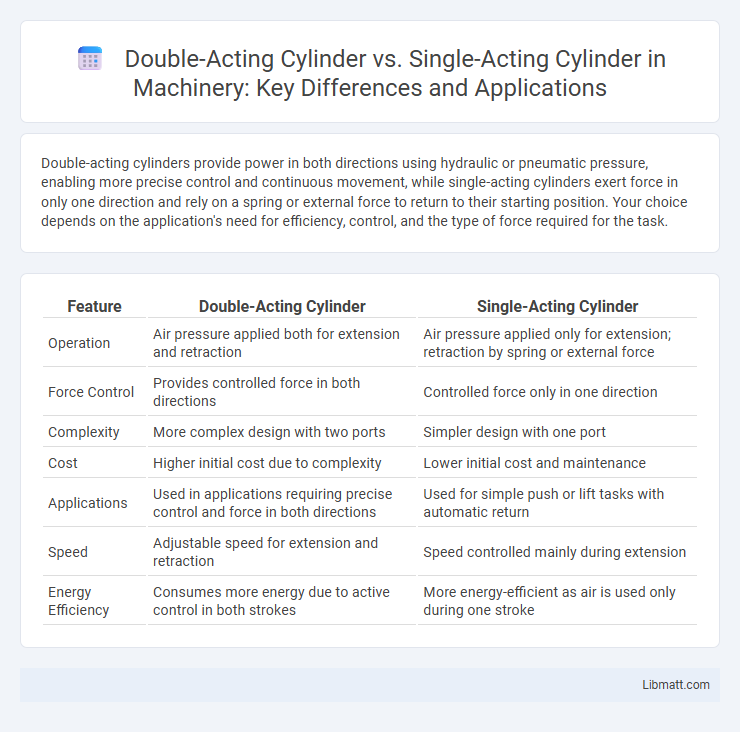Double-acting cylinders provide power in both directions using hydraulic or pneumatic pressure, enabling more precise control and continuous movement, while single-acting cylinders exert force in only one direction and rely on a spring or external force to return to their starting position. Your choice depends on the application's need for efficiency, control, and the type of force required for the task.
Table of Comparison
| Feature | Double-Acting Cylinder | Single-Acting Cylinder |
|---|---|---|
| Operation | Air pressure applied both for extension and retraction | Air pressure applied only for extension; retraction by spring or external force |
| Force Control | Provides controlled force in both directions | Controlled force only in one direction |
| Complexity | More complex design with two ports | Simpler design with one port |
| Cost | Higher initial cost due to complexity | Lower initial cost and maintenance |
| Applications | Used in applications requiring precise control and force in both directions | Used for simple push or lift tasks with automatic return |
| Speed | Adjustable speed for extension and retraction | Speed controlled mainly during extension |
| Energy Efficiency | Consumes more energy due to active control in both strokes | More energy-efficient as air is used only during one stroke |
Introduction to Pneumatic Cylinders
Pneumatic cylinders convert compressed air energy into mechanical motion for automation applications, with two main types: double-acting and single-acting cylinders. Double-acting cylinders use air pressure for motion in both extension and retraction, providing more precise control and faster operation. Single-acting cylinders rely on air pressure for movement in one direction and a spring for return, offering simplicity and cost-effectiveness in applications requiring only one power stroke.
What is a Single-Acting Cylinder?
A single-acting cylinder uses hydraulic or pneumatic pressure to move the piston in one direction, while a spring or external force returns it to the original position. This type of cylinder is simpler and typically used in applications requiring force in only one direction, such as clamping or lifting. Single-acting cylinders offer cost efficiency and reduced complexity compared to double-acting cylinders, which require pressure for both extension and retraction.
How Double-Acting Cylinders Work
Double-acting cylinders operate by using hydraulic or pneumatic pressure on both sides of the piston to create movement in two directions, allowing precise control and increased force during both extension and retraction. These cylinders feature two ports for fluid input and output, enabling continuous motion without relying on external mechanisms like springs. The dual-pressure design makes double-acting cylinders ideal for applications requiring consistent force and speed in both directions, such as industrial automation and robotics.
Key Differences Between Single-Acting and Double-Acting Cylinders
Single-acting cylinders utilize hydraulic or pneumatic pressure to move the piston in one direction while a spring returns it, making them simpler and cost-effective for applications requiring unidirectional force. Double-acting cylinders apply pressure alternately on both sides of the piston, enabling controlled movement in both extension and retraction, which enhances precision and power in complex machinery. The choice between single-acting and double-acting cylinders depends on operational needs such as required force direction, speed, and control complexity in industrial automation or manufacturing processes.
Advantages of Single-Acting Cylinders
Single-acting cylinders offer simplicity and cost-effectiveness due to their single-port design, requiring less maintenance and fewer components compared to double-acting cylinders. They are ideal for applications needing force in only one direction and use a spring or external force for return movement, enhancing energy efficiency. Their compact structure and ease of installation make single-acting cylinders suitable for light-duty industrial machinery and pneumatic tools.
Benefits of Double-Acting Cylinders
Double-acting cylinders offer enhanced control and power by providing force in both extension and retraction strokes, making them ideal for applications requiring precise movement and consistent force. These cylinders improve operational efficiency in automated systems by enabling faster cycle times and reducing reliance on external return mechanisms like springs. Their versatility and reliability suit industrial machinery, robotics, and heavy equipment, where bidirectional force is crucial for optimal performance.
Applications for Single-Acting Cylinders
Single-acting cylinders excel in applications requiring a simple push or pull force with the use of an external force or spring for return, such as in clamping, stamping, or lifting operations. These cylinders are ideal for systems where space constraints and cost-effectiveness are crucial, often found in agricultural machinery, packaging equipment, and material handling. Their design allows for easy maintenance and reliable performance in repetitive tasks with consistent load demands.
Use Cases for Double-Acting Cylinders
Double-acting cylinders are ideal for applications requiring controlled movement during both extension and retraction phases, such as automated machinery, robotics, and industrial presses. Your systems benefit from enhanced precision and force in both directions, improving efficiency in repetitive tasks like clamping, lifting, and pushing. These cylinders excel in environments where consistent two-way power is essential, outperforming single-acting alternatives in versatility and control.
Choosing Between Single-Acting and Double-Acting Cylinders
Choosing between single-acting and double-acting cylinders depends on the application requirements for force direction and control precision. Single-acting cylinders provide power in one direction using hydraulic or pneumatic pressure with a spring or external force returning the piston, ideal for simple tasks with limited stroke control. Double-acting cylinders apply pressure alternately on both sides of the piston, offering greater versatility, precise positioning, and stronger force in both directions for complex machinery and automation.
Conclusion: Which Cylinder is Best for Your Needs?
Double-acting cylinders provide power in both extension and retraction, making them ideal for precise control and applications requiring consistent force in both directions. Single-acting cylinders rely on spring or external force for retraction, offering simplicity and cost-effectiveness for tasks with unidirectional force needs. Choosing the best cylinder depends on your application's specific force requirements, control precision, and budget constraints.
Double-acting cylinder vs single-acting cylinder Infographic

 libmatt.com
libmatt.com